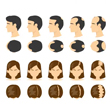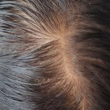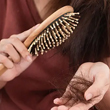Can Hormonal Imbalance Lead to Hair Fall?
Hormones are chemical substances produced by the body that regulate the activity of cells or organs. They control many vital functions, including growth, development, reproduction, and metabolism. Every hormone in your body is essential to your well-being.
Regulating hormonal secretions in the body is vital to maintaining good health. Imbalances in these secretions can lead to a range of health problems, including hair loss. Hair fall due to hormonal imbalance is proven in scientific research as well.
What is Hormonal Imbalance? 1,2
The term Hormonal Imbalance is used to describe any condition in which the amounts or functions of hormones in the body are not at their optimal levels. When this occurs, the functions and activities of multiple body systems and organs become disturbed and imbalanced.
Hormonal imbalance can be a leading cause of hair fall. A range of conditions causes the decrease in the number of active hormones:
- An alteration in their actions on the hair follicles, resulting from a disorder in the pituitary gland,
- An abnormality in the thyroid gland,
- A problem with the ovaries or testes, or
- A tumour in these glands.
- A lack of nutrients for hormone production.
Hair fall or excessive hair loss is one of the most visible effects of hormonal imbalance. In advanced stages, it may lead to baldness. There may also be an increased amount of dandruff.

You'll need to see your doctor if you have any of the conditions mentioned above. Get to know your hormones. Step back, take a holistic approach, look for root causes of hair fall, look out for patterns.
Is Hairfall Due to Hormonal Imbalance? 3
The hair cycle. and hair follicle structure are highly affected by various hormones.There are two types of androgen, T, and DHT. The former is found in both men and women while the latter only in men.

Androgens—such as testosterone (T); dihydrotestosterone (DHT); and their prohormones, dehydroepiandrosterone sulfate (DHEAS) and androstenedione (A)—are the critical factors in terminal hair growth.
The first thing that needs to be known is what exactly constitutes a 'hormonal imbalance.' Hormonal imbalance occurs when the T (testosterone) level in the blood is too high or too low. The same goes for DHT (dihydrotestosterone), which is T's active form. If there is too much of either T or DHT, it can lead to hair fall, among other problems
DHT is necessary for male pattern baldness because it is converted from T by five alpha-reductase enzymes into DHT, which binds with male pattern baldness genes on the scalp causing irreversible damage to follicles. This leads to miniaturization of follicles leading to hair loss.
For example, an excess of T leads to increased frequency of male pattern baldness, whereas too little leads to alopecia areata, which causes patchy hair fall along with inflammation.
Identify the Underlying Cause of the Problem 4
Knowing the cause, whether it's genetic or lifestyle-related, can help you take proactive actions towards controlling your hormonal problems. Like any other disorder, the hormonal imbalance has multiple causes, including genetic predisposition, stress, poor diet, and regular intake of certain medications.

The Major Causes of hormonal imbalance are listed below:
- Medications : Different kinds of drugs cause different side effects on our bodies, leading to various types of problems, including hormonal balance disturbance, which ultimately leads to Baldness & Hair Fall.
- Pregnancy & Childbirth : During pregnancy, progesterone level rises very high, which is not suitable for women suffering from Alopecia areata. Also, during childbirth, there are significant hormonal changes that can lead to hair loss.
- Menopause and Andropause (male menopause) are times when : Many women experience a hormonal shift that can lead to hair loss. Hormonal changes don't always lead to hair loss, but if you're experiencing thinning hair, it's essential to get your hormone levels checked. Many times hormone imbalance can be treated effectively with bio-identical hormones.
If you're experiencing hair loss, get your hormone levels checked! And remember that hormonal shifts can happen at any point in life. If you've just had a baby or are going through a change of life, you may notice your hair starting to thin.
Five Ways to Manage and Balance Your Hormones 5
Hormonal imbalances can cause hair loss and, if left untreated, may lead to permanent baldness. Talk to your doctor about possible treatments.
- Maintain a well-nourished Diet : Make sure you're getting enough protein in your diet. It's found in meats and eggs, quinoa, whole grains, pulses, and beans. Also, try zinc-rich foods like cashews, pumpkin seeds, peas, wheat germ, almonds, tofu. Avoid sugar as it increases cortisol levels.
- Exercise frequently : If you have long hair, tie it up while working out. This will prevent hair breakage caused by friction during vigorous workouts.
- Hydrate yourself : Drink water with lemon for better absorption of nutrients into the body.
- Sleep well : Go to bed early so that you have enough sleep. Also, reduce the intake of alcohol which lowers testosterone levels in men by 10%.
- Check with your doctor first : Don't immediately jump into a treatment plan without understanding what's happening with your hair, first speak with a dermatologist or a hair loss specialist. He will examine your hair and scalp and ask questions about your health, family history, lifestyle, diet, and other factors that could affect the condition of your hair.
Conclusion 6
Find out where your hair loss is coming from and when to see a dermatologist. The good news is that most hormonal imbalances can be treated with medications.
The treatment for hormonal imbalance depends on the underlying problem. For example, in some cases, stress or certain health conditions may be the reason behind hormonal imbalance. In others, your body may be producing too much or too little of a particular hormone.
Myth Busters HairFall

Androgenetic Alopecia - Everything You Need To Know
Have you been experiencing excessive hair fall over a prolonged period of time? It could be an early sign of androgenetic alopecia. It is a hair loss disorder common in both genders and can lead to progressive thinning and even baldness in some patients if not caught and treated early.

How To Make Hair Grow Faster For Men
A head full of healthy hair is a matter of confidence. Hair has its own mechanism of growing and shedding, and it is when this mechanism is thrown off that growth is hindered. Especially in the case of males, hair growth faces a lot of hiccups that can easily be managed.

Female Pattern Baldness - Causes & Treatments
Have you suddenly noticed an increase in the number of hair strands on your pillow in the morning? Or is your ponytail getting thinner by day? Well, you might be suffering from female pattern baldness. While that does sound scary, identifying it early on is key to treating this condition effectively. So keep reading to know what this is, how you can identify it, and most importantly, what treatments you can avail of to get your beautiful lustrous hair back.

What Are The Reasons For Hairfall?
Almost everyone experiences some amount of hair thinning over the years. Shedding around 50 to 100 single strands of hair per day is considered normal. However, losing more than 150 strands a day, experiencing sudden thinning, or developing circular bald patches on your scalp are reasons for concern. Hair loss occurs when new hair doesn’t grow fast enough to replace the amount of hair you lose daily. Hair can fall due to various reasons, with hereditary hair loss and poor nutrition being the most common hair fall reasons.

Expert Approved Tips For Hair Growth
What can be more debilitating than seeing hundreds of hair strands shedding from your scalp every time you brush your hair? Also, excessive molting occurs during seasonal changes that can be very stressful for you. Although it’s okay to lose between 50-100 strands every day, according to the American Academy of Dermatology, the problem occurs when you start shedding more than normal. But that doesn’t mean you have to feel helpless as there are ways to grow your hair back. Even if you are coping with baldness or alopecia, certain hair growth tips from dermatologists can come to your rescue. Read on to discover how these tips can be your savior when abnormal hair fall problems are in sight.
Trending Videos
+ 6 Sources
'LMRC - GGI-CO-A2-DMA-300001252-300001252-WM-L21-704'
© 2021 Dr. Reddy’s Laboratories Ltd. All rights reserved.